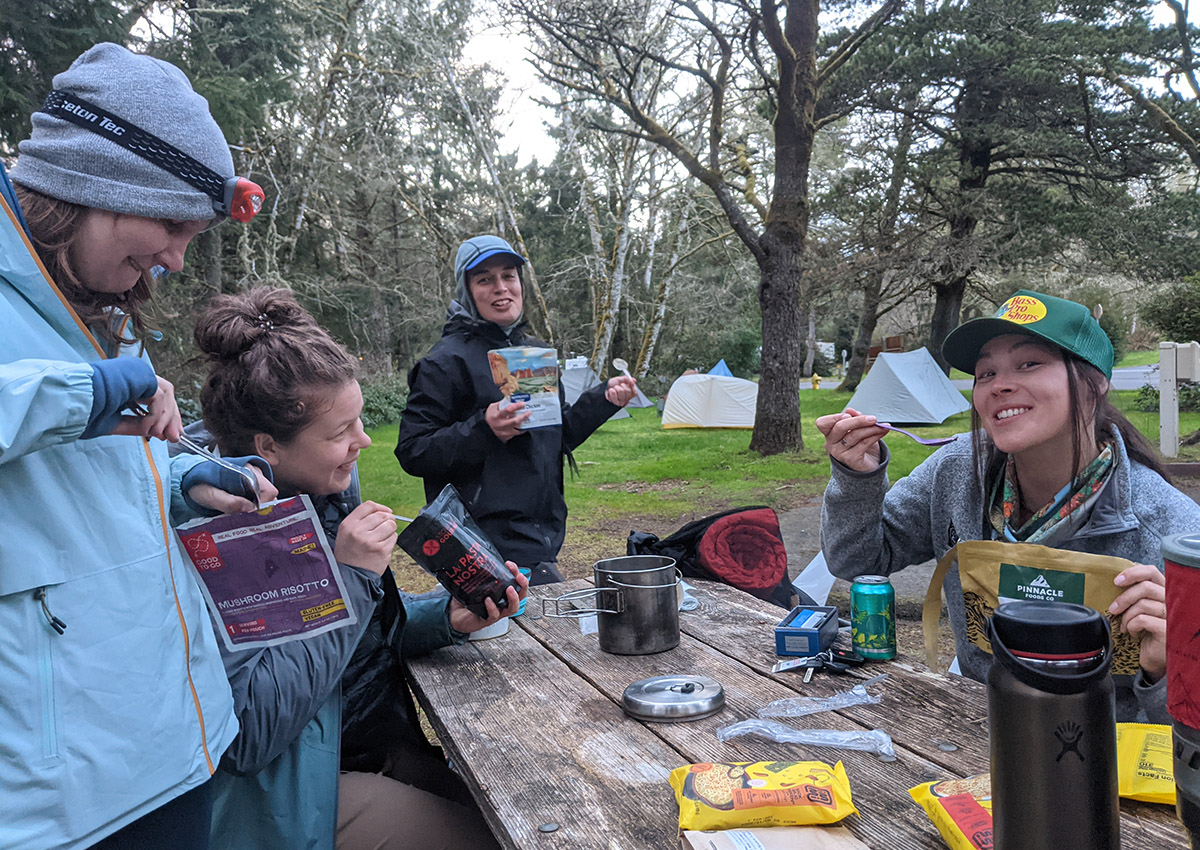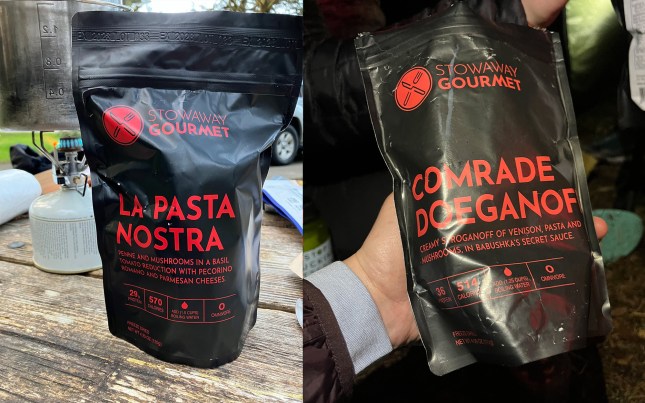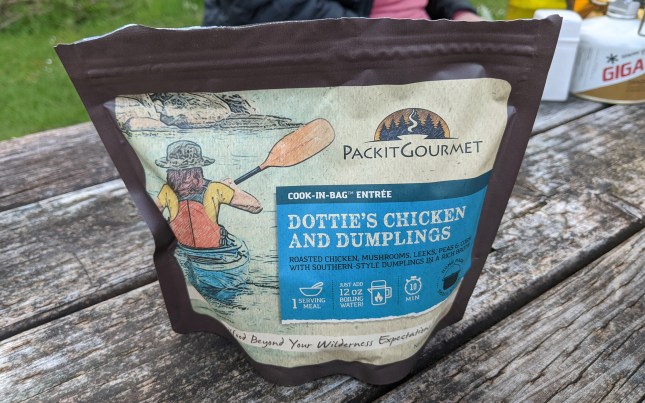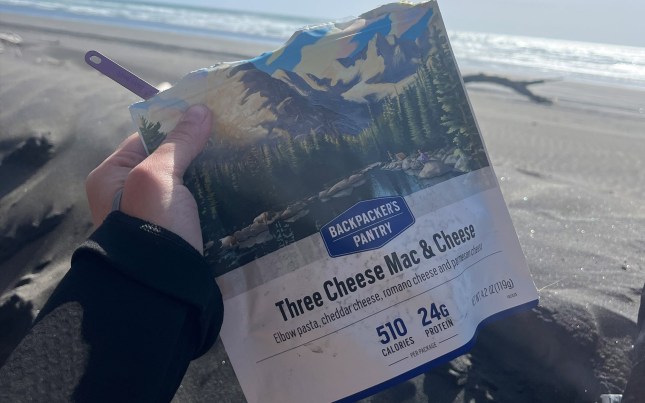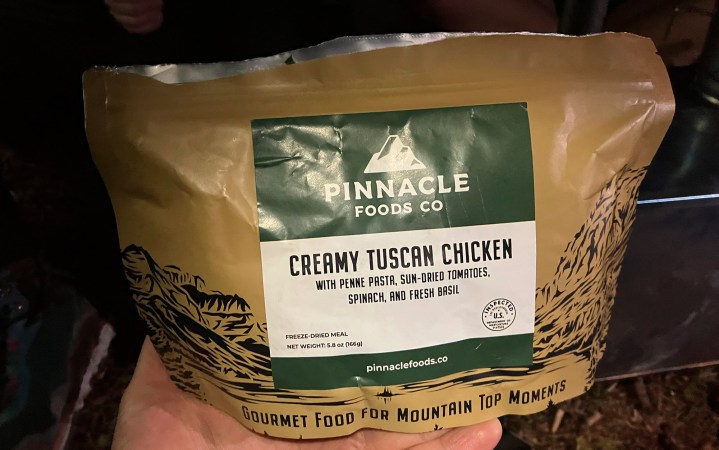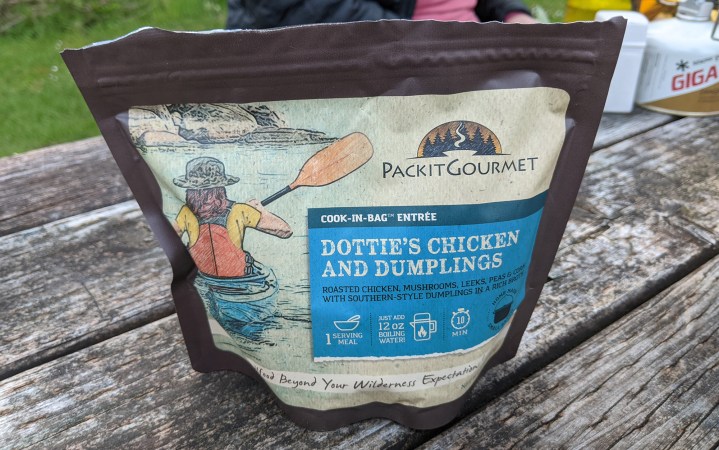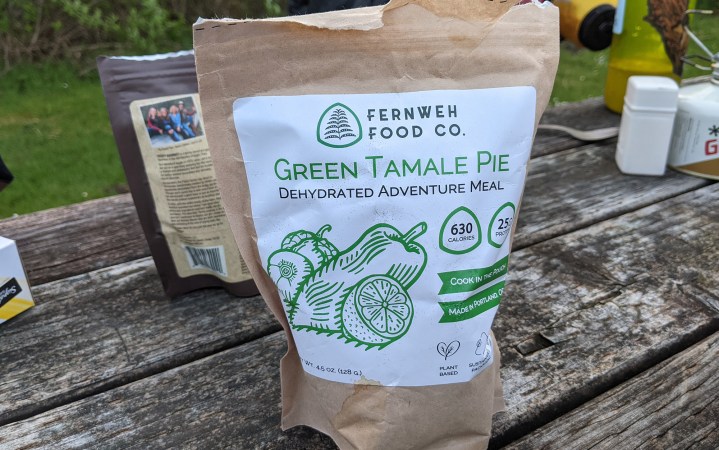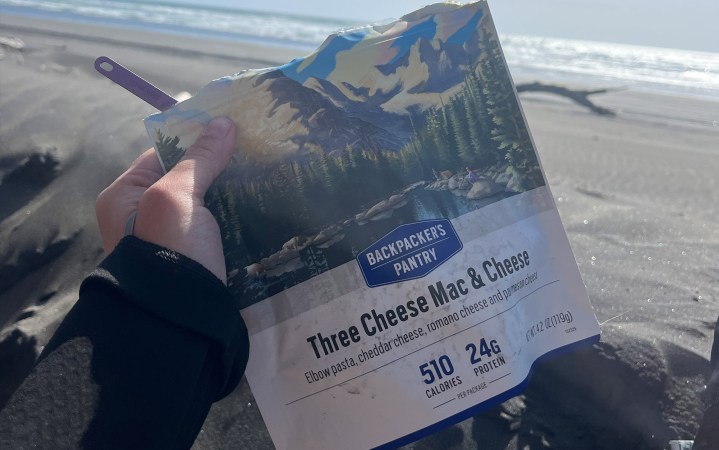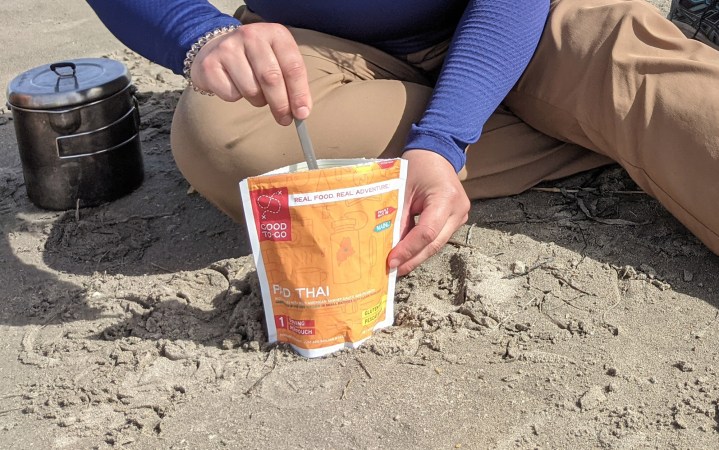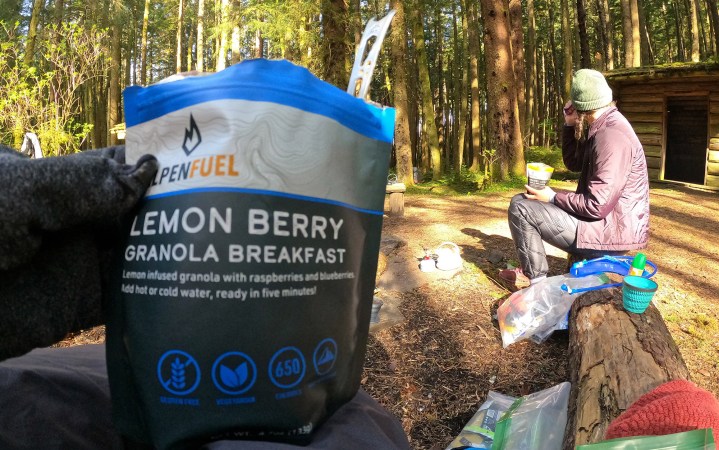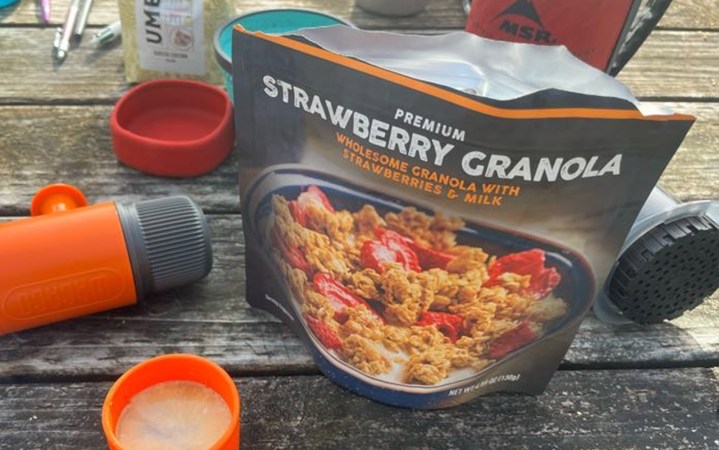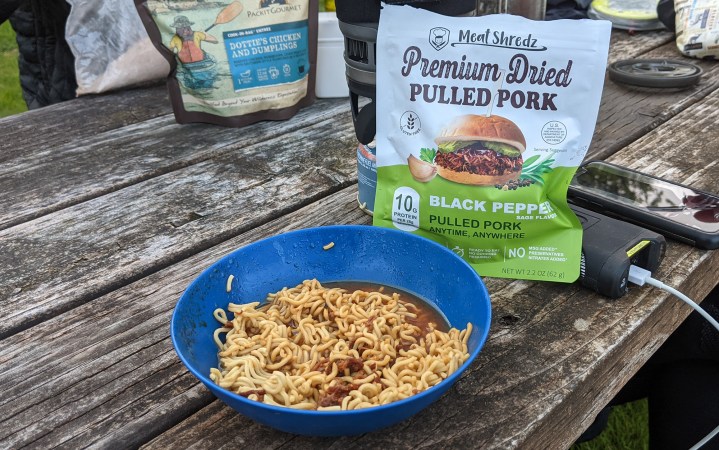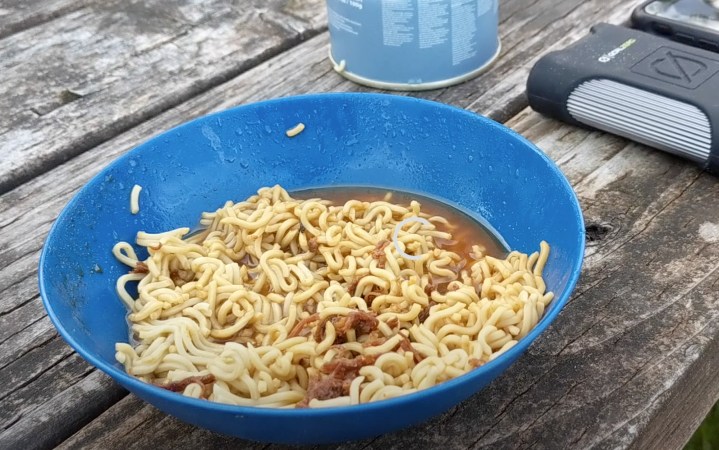We may earn revenue from the products available on this page and participate in affiliate programs. Learn More ›
“If I told you that you had to eat one more dehydrated backpacking meal instead of a town meal, which would you pick?” Collective groans ensued.
After three days of eating nothing but freeze-dried or dehydrated food, assessing them for weight, taste, caloric density, and how they made our bodies feel, we’d had enough. But we also had plenty of opinions about which of the best backpacking food brands we’d take with us into the field again. And then we promptly ordered burgers and fries.
Backpacking foods are freeze-dried or dehydrated meals that are lightweight and shelf-stable for long trips into the backcountry, which can make them less tasty and harder to digest than a fresh meal. But, there are companies making delicious and nutritious backpacking meals. Five experienced backpackers tested them all—good and bad—and rated them on preparation, taste, nutritional value, and how they made us feel. Here are our picks for the best backpacking food:
- Best Tasting: Stowaway Gourmet
- Best Tasting Runner-Up: Pinnacle Foods
- Best Value: Packit Gourmet
- Best Vegan: Fernweh Food Co
- Best Accessible: Backpacker’s Pantry
- Best Gluten-Free: Good to Go
- Best Granola: Alpen Fuel
- Highest Calorie: Peak Refuel
- Best Add-On: Meat Shredz Premium Dried Pulled Pork
- Best Instant Ramen Upgrade: Immi
| Our Top 7 Favorite Entrees | Calorie Ratio | Protein | Sodium | Cook Time | Water | Enthusiasm | Price |
| Stowaway Gourmet Lamb Bourguignon | 176.25 | 36 grams | 1,424 milligrams | 10 minutes | 1.25 cups | 5 | $19.95 |
| Pinnacle Foods Italian Sausage and Zesty Tomato Sauce with Farfalle Pasta, and Parmesan | 163.27 | 38 grams | 1,570 milligrams | 12 minutes | 1.5 cups | 4 | $15.99 |
| Packit Gourmet Curry Mango Chicken Salad | 134.38 | 40 grams | 470 milligrams | 15 minutes | 5 ounces | 5 | $12.99 |
| Fernweh Green Tamale Pie | 140 | 25 grams | 1,320 milligrams | 15-17 minutes | 1.5 cups | 3 | $16.50 |
| Backpacker’s Pantry Fettucini Alfredo with Chicken | 116 | 40 grams | 1,450 milligrams | 15 minutes | 1.5 cups | 3 | $12.99 |
| Good to Go Chicken Pho (double serving) | 116.42 | 53 grams | 2,430 milligrams | 10 minutes | 1.5 cups | 3 | $15.50 |
| Peak Refuel Chicken Pesto Pasta | 161.12 | 43 grams | 900 milligrams | 10 minutes | 5 ounces | 3 | $13.99 |
Enthusiasm is a cumulative score of taste and post meal feel.
How We Tested the Best Backpacking Food
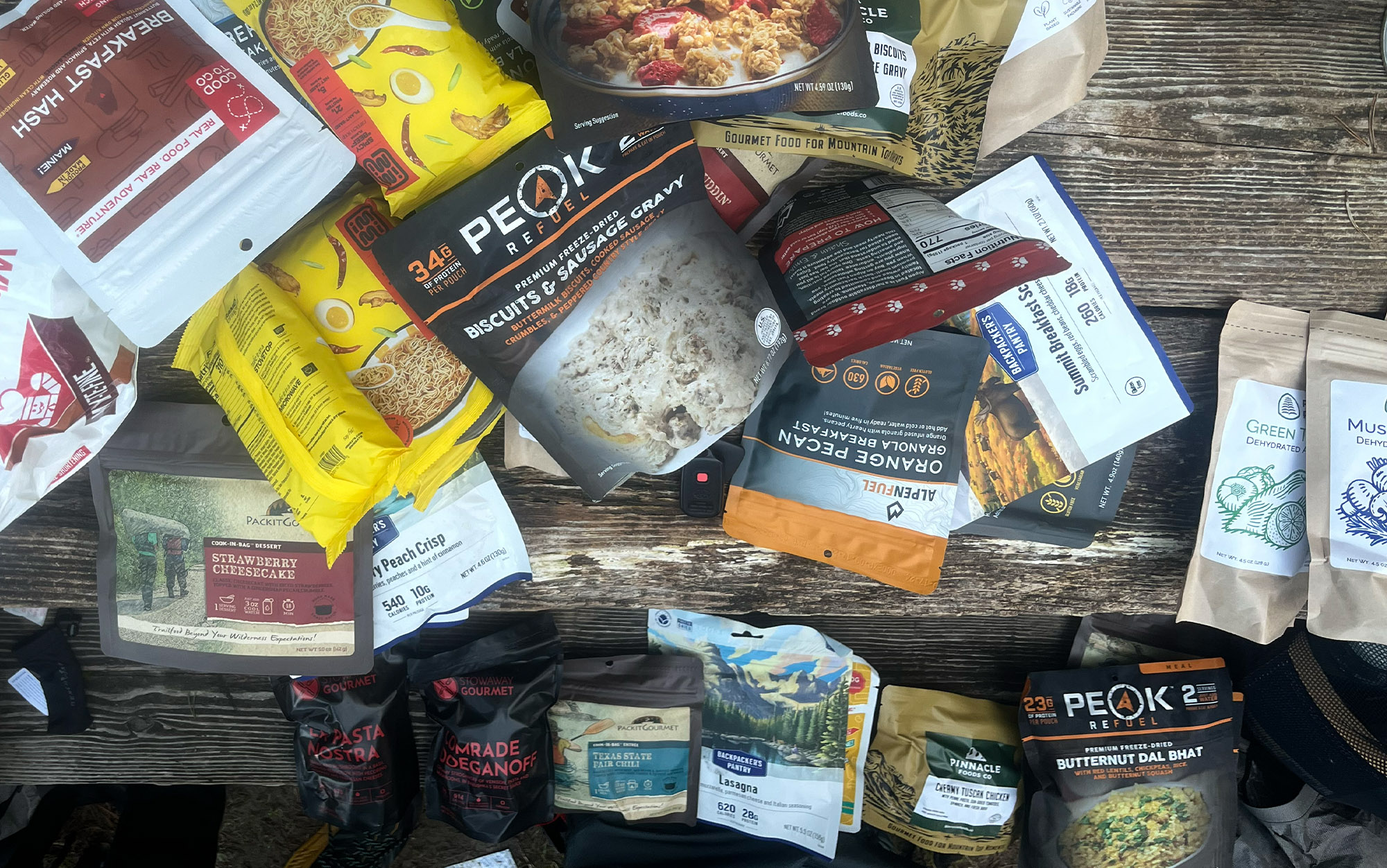
During the Outdoor Life Backpacking Gear Test, five testers ate backpacking food for eight meals straight over the span of four days. Organizer Laura Lancaster asked our resident dehydrated food expert, OL contributor Patrice La Vigne, if all three meals for the entire trip was too much to ask of people. But Patrice cheerily retorted, “Oh yeah; the food is great now. It’ll be fine!”
Reader, it was not fine.
While the backpacking food we tested was mostly tasty, the consequences of eating heavy, sodium-laden, dehydrated food for three days straight became apparent very quickly. After driving 13 hours from Salt Lake City, Utah, to the Oregon Coast, I was greeted with a meal full of 1,570 milligrams of sodium. After sitting all day and eating road food, I certainly did not need this much salt. But I have a little thing called professional integrity, so I ate it. For you, dear reader.
How We Graded Backpacking Food
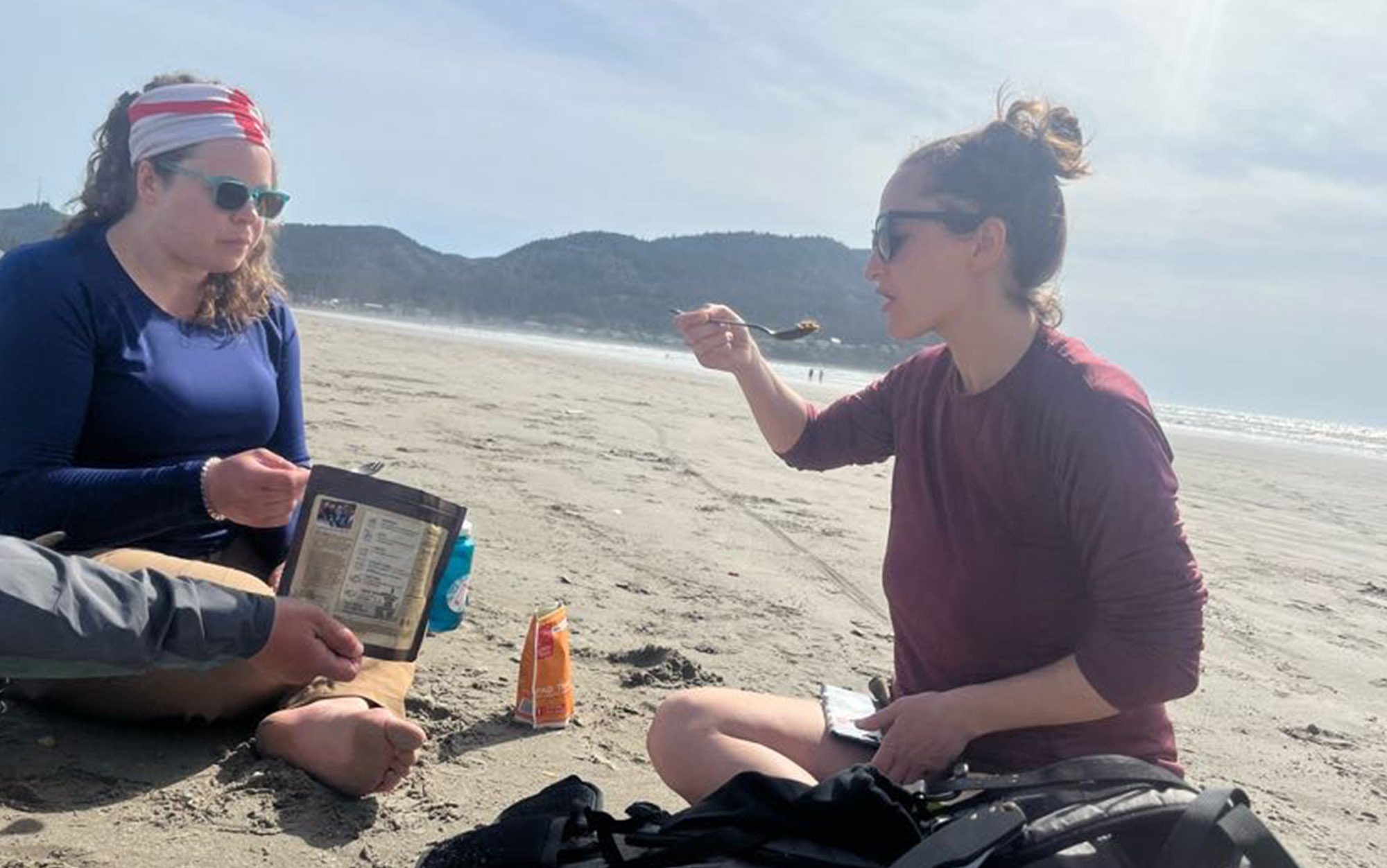
The brands on this list use real food in their meals and don’t have frightening fillers or unpronounceable ingredients. We based our test criteria on the fact that backpacking food must be lightweight, tasty, and will give you the nutrients to complete your trip.
The listed weights in the key features are net weights, meaning without the packaging. We also carried them 35 miles over five days of testing.
We evaluated each meal on the following criteria:
- Taste (Is this something we want to eat after a long hike?)
- Nutritional Value (We checked the ingredients and the nutritional facts to see if the meals have the proper balance for backpacking.)
- Preparation (How easy is the meal to prepare?)
- Post Meal Feel (How did we feel after eating the meal?)
The nutritional value of each meal includes sodium, protein, fiber, and calorie contents. We also made sure the ingredients were whole foods with the nutrients necessary to complete your trip. We list enthusiasm in out top seven favorite entrees table as a combination of taste and post meal feel. It shows how excited we would be to eat this meal again on a 1 to 5 scale. Preparation includes the required amount of water, cook time, and how well the meal rehydrated.
Best Backpacking Food: Reviews & Recommendations
Best Tasting: Stowaway Gourmet
Key Features
- Price: $16.95-$19.95
- Shelf Life: 5 years
- Net Weight: 3.4-5.2 ounces
- Protein: 12-43 grams
- Calories: 435-704
Pros
- Tastes like fine dining at a five star restaurant
- Lightweight
- Unique
Cons
- Expensive
These backpacking meals are indeed gourmet. With favorites like Lamb Bourguignon and Comrade Doeganoff, we were thrilled to indulge in these delicious and filling entrees. The lamb included sweet potato chunks and a red wine reduction. The Doeganoff had large pieces of venison and a creamy consistency. I think the unique protein choices like venison, wild boar, and bison give Stowaway Gourmet an edge, too. Besides protein they also replenish your iron levels which can deplete during endurance activities. The meat chunks are sizable and make you feel like you’re eating a home-cooked meal, which you are, just a freeze-dried one.
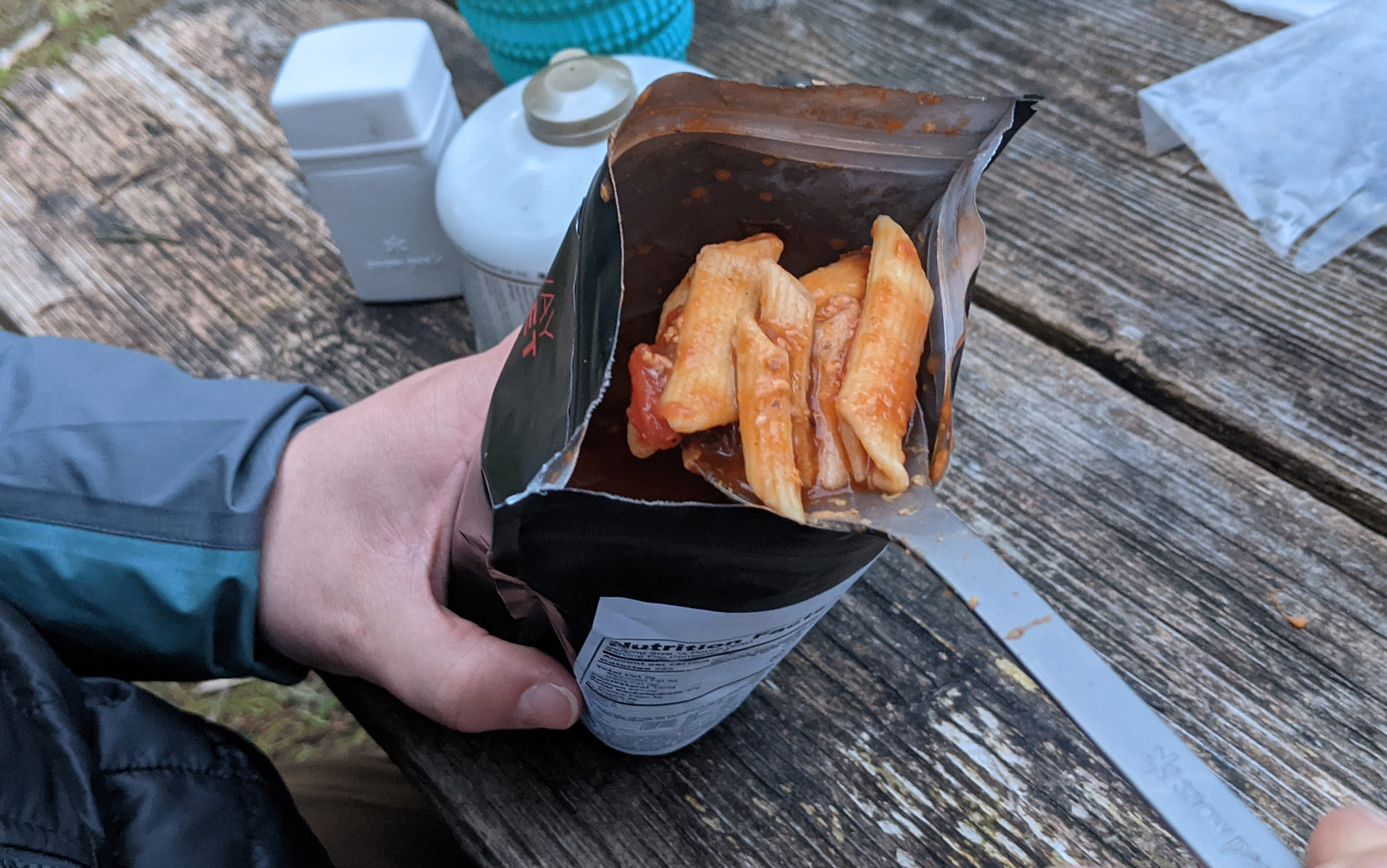
The cook time is just 10 minutes, if stirred properly, so you can enjoy your dinner sooner than others on this list. Stowaway Gourmet meals are decadent and filling, but nutritious with a respectable amount of sodium, around 33 percent of your daily value. If you’re headed to a spectacular vista or introducing someone to the backcountry, these are a great idea. However, with the rich flavors and $20 price tag, these might not suit you for breakfast, lunch, and dinner everyday. It is also listed as two serving sizes, but trust me, these are too good to share.
Best Tasting Runner-Up: Pinnacle Foods
Key Features
- Price: $16
- Shelf Life: 1 year (Omnidegradable bags) or 5 years (retort bag)
- Net Weight: 3.5-5.1 ounces
- Protein: 25-53 grams
- Calories: 550-850
Pro
- Reminded us of our favorite frozen Trader Joe’s meals
- Biodegradable bag option
- Short bag option
Cons
- High sodium
If Stowaway Gourmet is restaurant food quality, Pinnacle is Trader Joe’s quality, which tastes like a delicious treat in the backcountry. The Italian Sausage and Zesty Tomato Sauce with Farfalle Pasta, and Parmesan was a perfectly filling meal and tasted like a weeknight dinner I might make for myself at home. However, the sodium was 68 percent of the daily value. I had the Jalapeno Cheddar Biscuits and Herbed Sausage Gravy for breakfast and while it was also delicious, it was 55 percent of my daily sodium intake, meaning I was topped out after two meals. Some of the biscuits stayed crispy for a welcome texture change; I only wish it had more jalapeno as the spice was very mild.
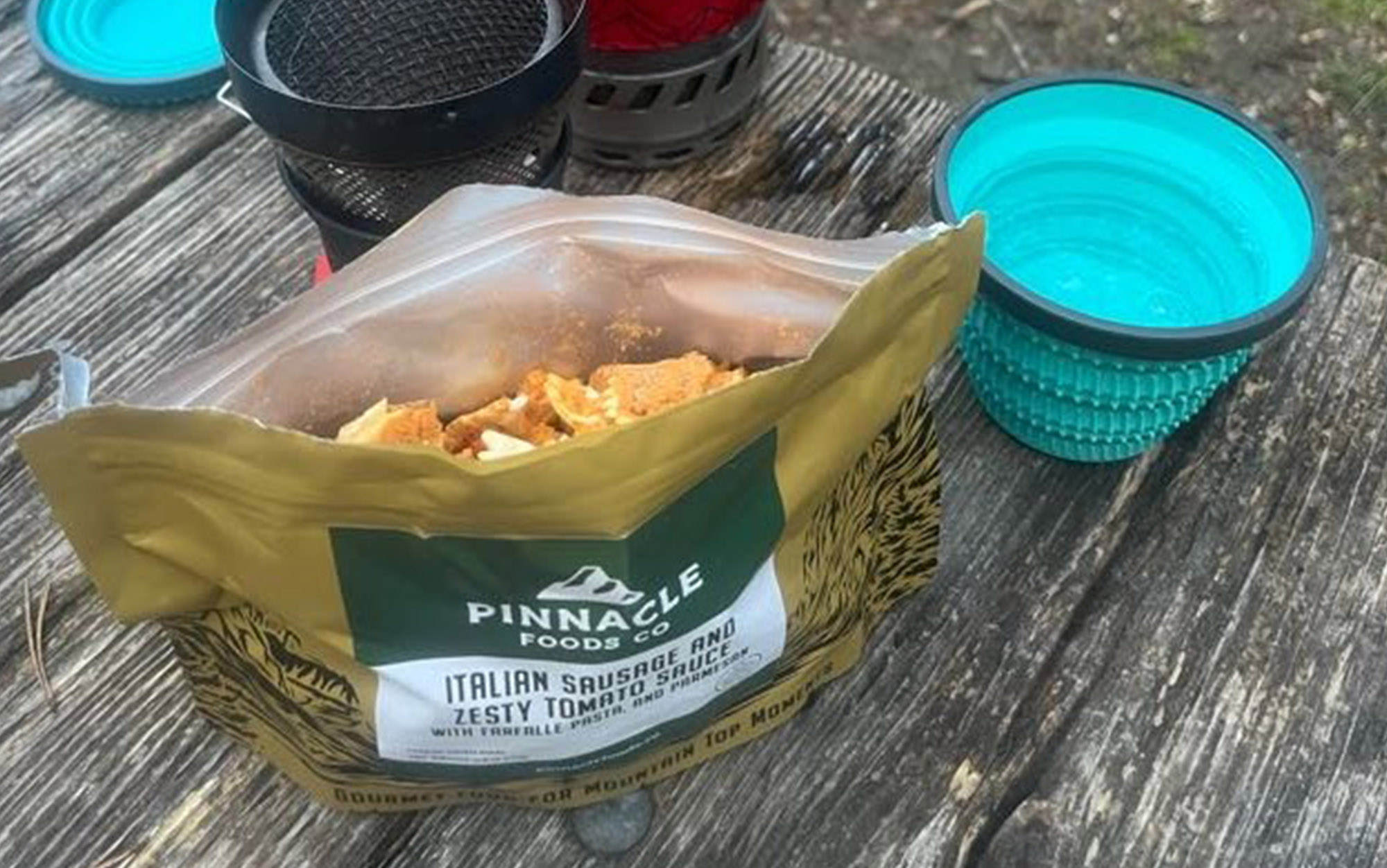
Pinnacle backpacking food is sold in either the Omnidegradable bags or the retort bags. The Omnidegradable version is compostable, making it great for the environment but less capable of preserving its contents; these meals are only good for a year. The Retort bags aren’t compostable, meaning they are more rugged and able to stand up to poor conditions on a long trip. These bags are also wide and shallow allowing for better access with a normal length spork making preparation easier so you can properly stir.
Best Value: Packit Gourmet
Key Features
- Average Entree Price: $14
- Shelf Life: 18 months
- Net Weight: 3.2-7.4 ounces
- Protein: 23-50
- Calories: 370-800
Pros
- Made us feel like mom packed a homemade meal for the trail
- Creative
Cons
- Takes a while
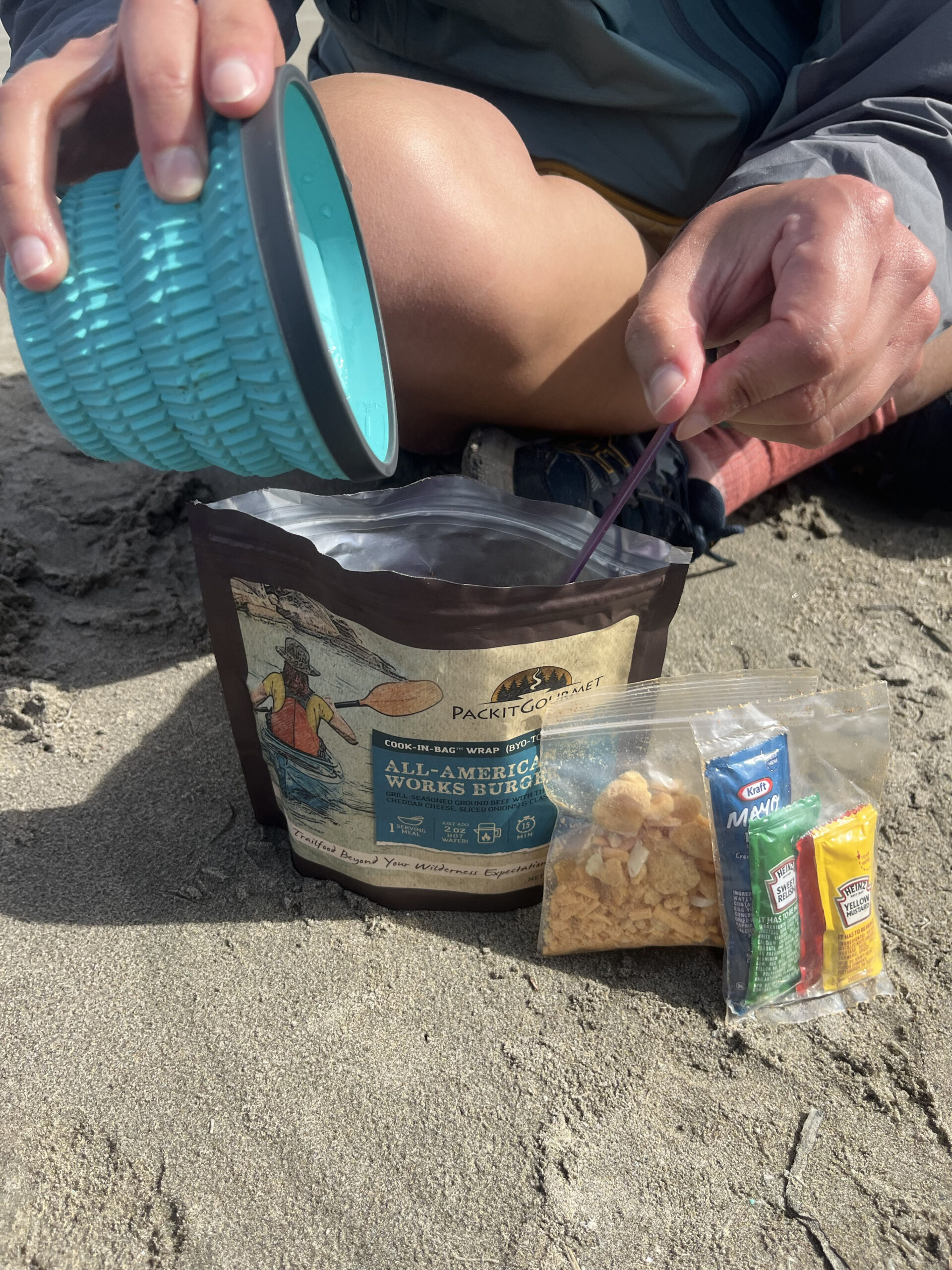
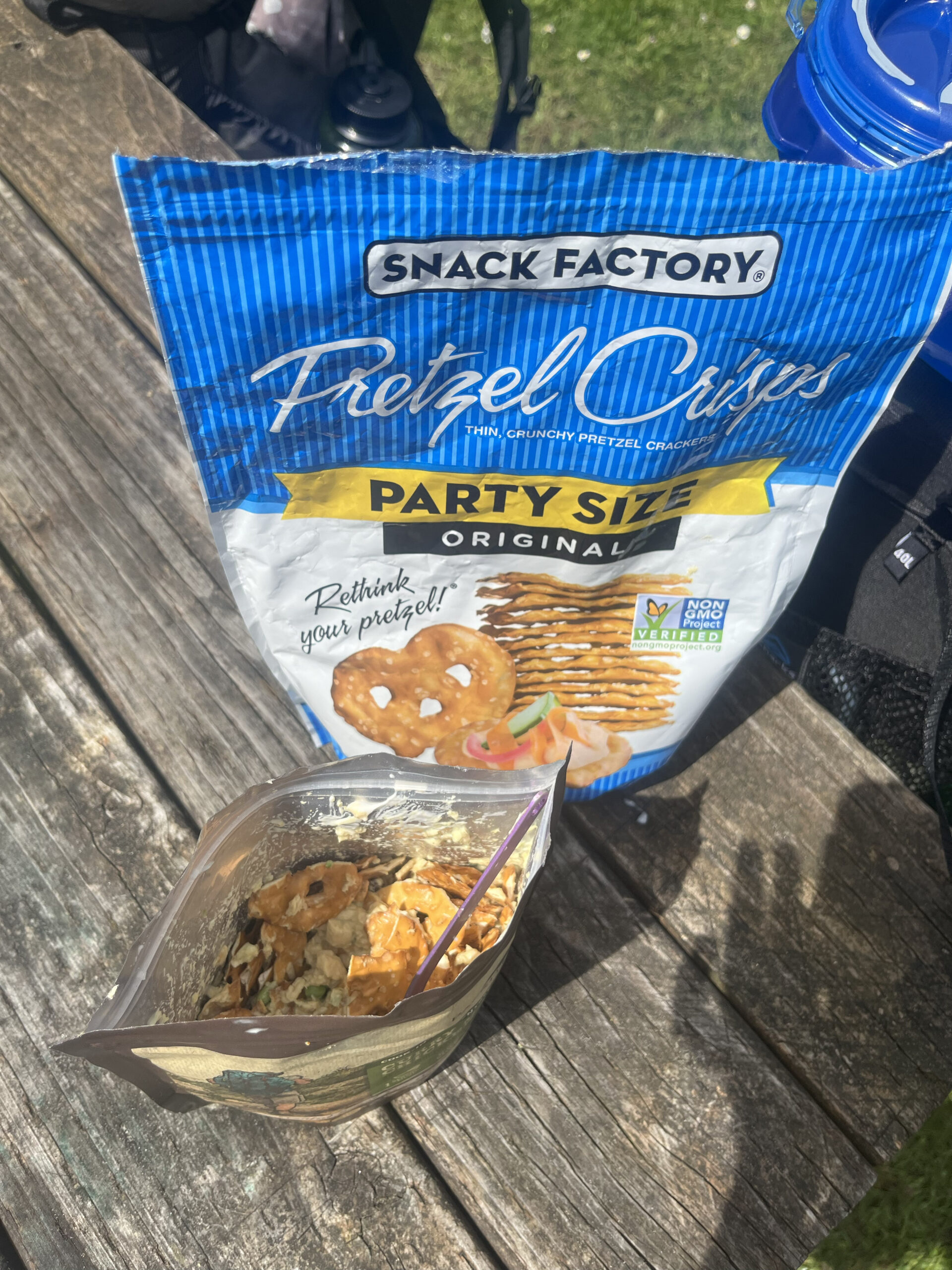
The creativity and attention to detail in these meals is amazing. The Mango Curry Chicken Salad tastes like it’s from a deli and the All-American Burger Works was a fan favorite. Both include a separate bag containing condiment packets and are made of the ingredients and flavors we actually crave on trail. Think about the amount of times you wanted a fresh salad for lunch or craved a burger on trail. And since Packit Gourmet uses whole, quality ingredients, the nutritional value is comparable to the real thing.
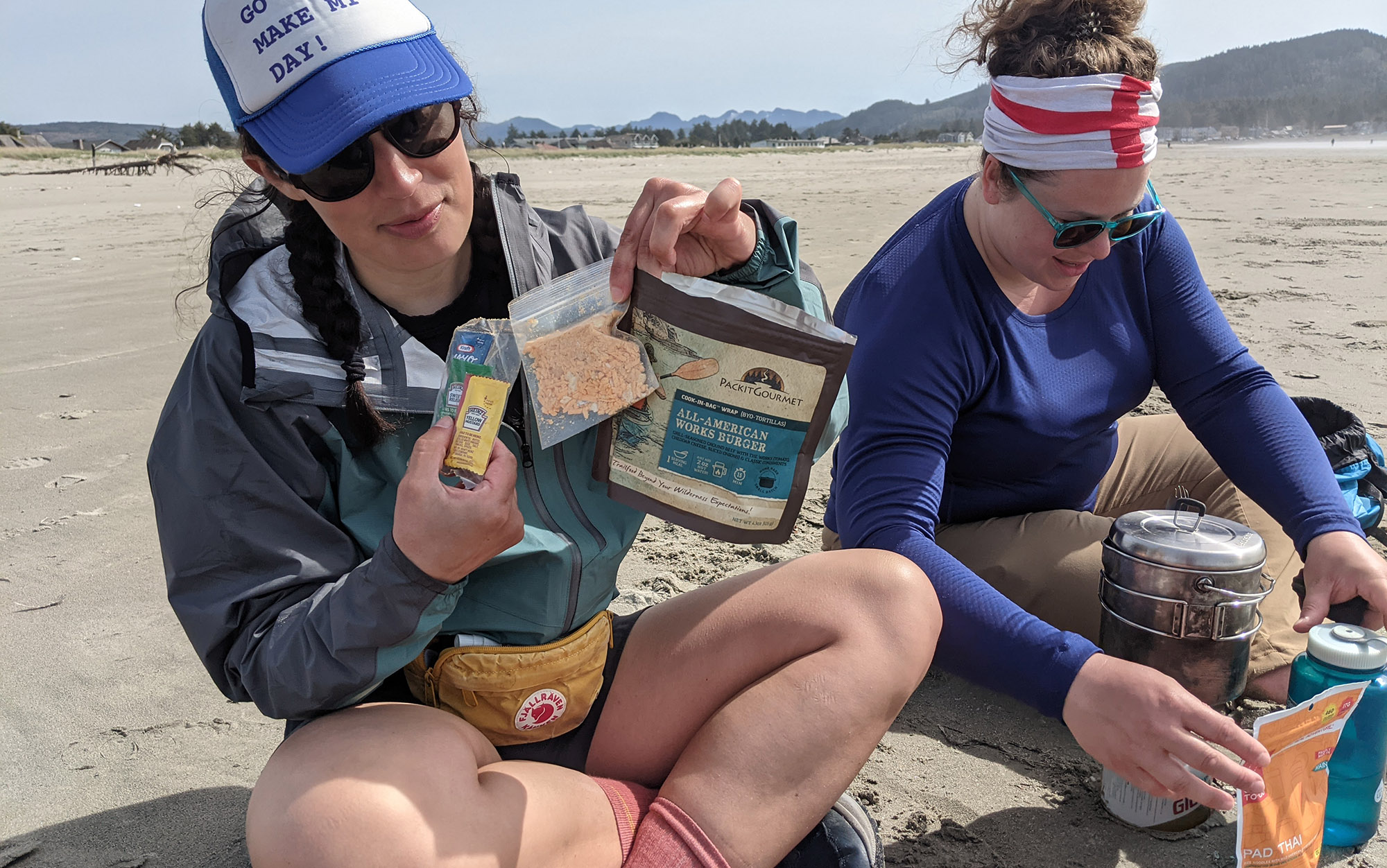
Packit Gourmet also sells a Happy Hour Queso Rico Dip and Happy Hour Pico de Gallo that were tasty and unique. Celebrating happy hour on trail with treats like these is a real morale boost. I would recommend heating the queso in a pot because it cools off too much in the bag as it rehydrates. The salsa looked and tasted like real salsa. Both bags were difficult to get chips in and out of though.
Best Vegan: Fernweh Food Co
Key Features
- Average Price: $14.54
- Shelf Life: 1 year
- Net Weight: 4.5 ounces
- Protein: 11-25 grams
- Calories: 520-630
Pros
- Gluten-free
- Vegan
- Compostable packaging
Cons
- Less calories and protein
- Hit and miss flavor wise compared to other brands
These gluten-free, plant-based meals are a great protein-rich option for vegans and vegetarians, but were hit and miss in terms of flavor. Our testers thought that the Morning Glory Bowl was rich and dense—too dense to finish, as it turned out. Others had too much going on, possibly being over seasoned. One tester described it as a flavor journey, discovering new ingredients with every bite. If you’re sick of mashed potatoes and mac and cheese, this is a good way to shake up your routine. The Green Tamale Pie was one of our favorites, with a good flavor, giving you what you want in a tamale with a surprisingly tasty cornbread topping.
The meals rehydrated well, and the bags are also Omindegradable meaning the shelf life is one year and the packaging is compostable. Fernweh’s backpacking food is a great sustainable option for those looking for new and creative flavor profiles that allow for dietary restrictions. The calorie count and protein content are understandably lower, and testers said they’d like more fat and substance to keep them energized.
Best Accessible: Backpacker’s Pantry
Key Features
- Average Entree Price: $10
- Shelf Life: 3-10 years
- Net Weight: 2.3-6.7 ounces
- Protein: 13-41 grams
- Calories: 300-820
Pros
- High-calorie
- Good price point
- Easy to find in retail stores
Cons
- Hit or miss flavors
While a lot of these meals are online only or sold in specific retail locations, Backpacker’s Pantry is stocked at REI and ranges from $7 to $13. The meals list the serving size as two, which may be accurate for relaxed days, but if you’re hiking a lot it’s easy to eat the entire package yourself. If it’s your first time eating Backpacker’s Pantry, play it safe and assume everyone will need their own meal.
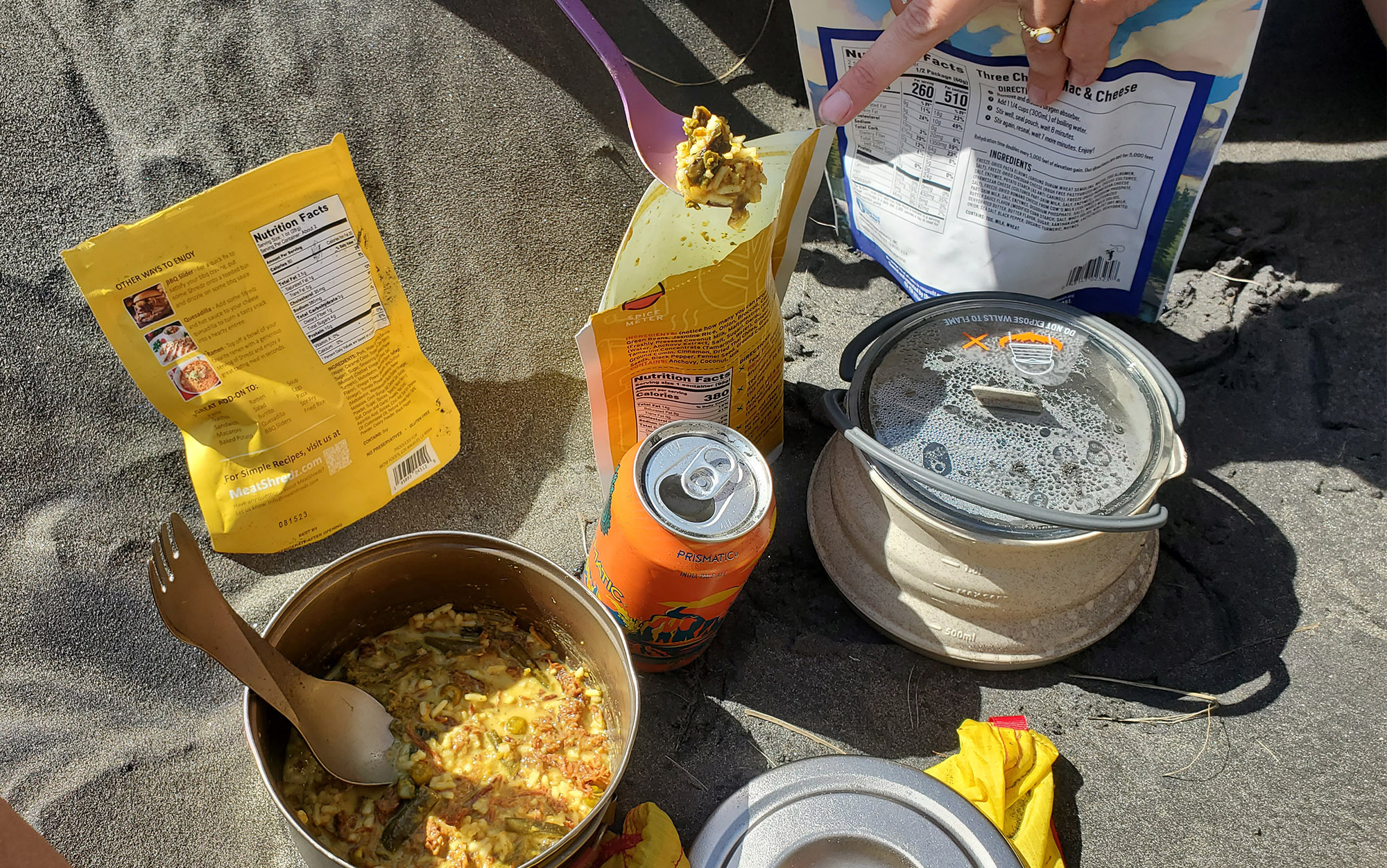
As far as taste goes, the food can be hit or miss. While international flavors abound in backpacking food, when it comes to Backpacker’s Pantry I would recommend sticking with the Western classics like the Three Cheese Mac and Cheese and Lasagna. The seasoning in the Pad Thai and Chicken Larb are off and don’t taste as good. The Pad Thai didn’t taste like Pad Thai, just nondescript Asian noodles with unpleasantly funky flavor. The Chicken Larb was overwhelmingly seasoned, especially with mint giving the impression that you’re eating ground chicken mixed with toothpaste.
The sodium levels in Backpacker’s Pantry vary with some meals containing as much as 1,750 milligrams. The prep time is reasonable and recommends stirring halfway through which I think helps make sure the entire meal rehydrates. With a lot of calories and protein, these are good for replenishing after a long day on the trail.
Best Gluten-Free: Good to Go
Key Features
- Price: $8.60 (single serving) $15.50 (double serving)
- Shelf Life: 4-5 years
- Net Weight: 4.9-6.7 ounces
- Protein: 13-16 grams per serving
- Calories: 350-540 per serving
Pros
- Lower sodium
- Gluten-free
- Vegan and vegetarian options
- Kind on the digestive tract than other options
Cons
- Some are bland
- Not calorie-dense
Good to Go meals are preservative-free, gluten-free, and lower in sodium. Some can also be rather bland. But this means that Good to Go meals were easier to digest than others. The Good to go options weren’t the best tasting, but they don’t make you uncomfortable afterwards. There are also a lot of vegan, vegetarian, and pescatarian options. All Good to Go meals are gluten-free so if you have a sensitivity or intolerance, you won’t have to worry about grabbing the right bag or someone eating the only gluten-free option. These should be stirred thoroughly to dig the seasoning off the bottom.
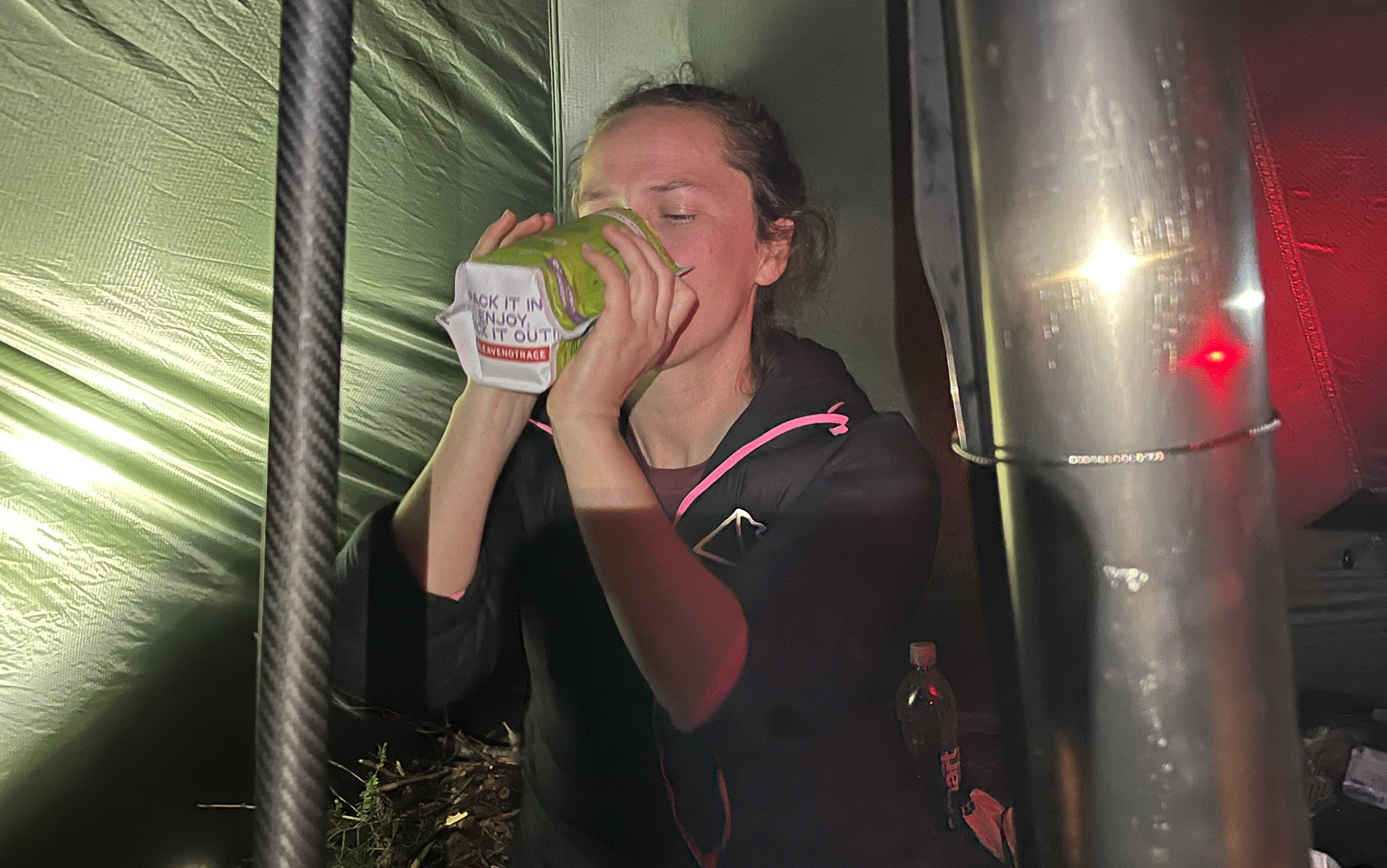
The calories and protein aren’t as high as other meals so I wouldn’t rely on just one serving after a long day. The Chicken Pho was a nice soup option, but OL staff writer Laura Lancaster had another meal as well to feel full. I split the Backpacker’s Pantry Three Cheese Mac and Cheese and the Good to Go single-serving Thai Curry with one tester for lunch on our longest day and it shows how backpacking food serving sizes can’t be trusted. Two people were only full after splitting technically three servings. So Backpacker’s Pantry isn’t enough for two people and Good to Go’s single-serving isn’t enough for one.
Best Granola: Alpen Fuel
Key Features
- Price: $9
- Shelf Life: 18 months
- Net Weight: 4.4-5.6 ounces
- Protein: 16-24 grams
- Calories: 720-770
Pros
- Calorie-dense
- Flavorful
Cons
- Sweet
Alpen Fuel makes decadent breakfast granolas that are high in calories, sugar, and flavor. Packaged granola might sound like a scam at first (we were confused). But after eating one, this is above and beyond grocery store granola. Eating these every morning would be too much for me, but if you like a sweet and filling jumpstart to the day, these are perfect. Patrice relished the Chocolate Strawberry Granola Breakfast but the rest of us found it overly sweet. Patrice asked, “Am I the only one that likes chocolate in the morning?” And I think she is. I loved the Caramel Apple Granola, but couldn’t finish it and ended up feeling hungry later.
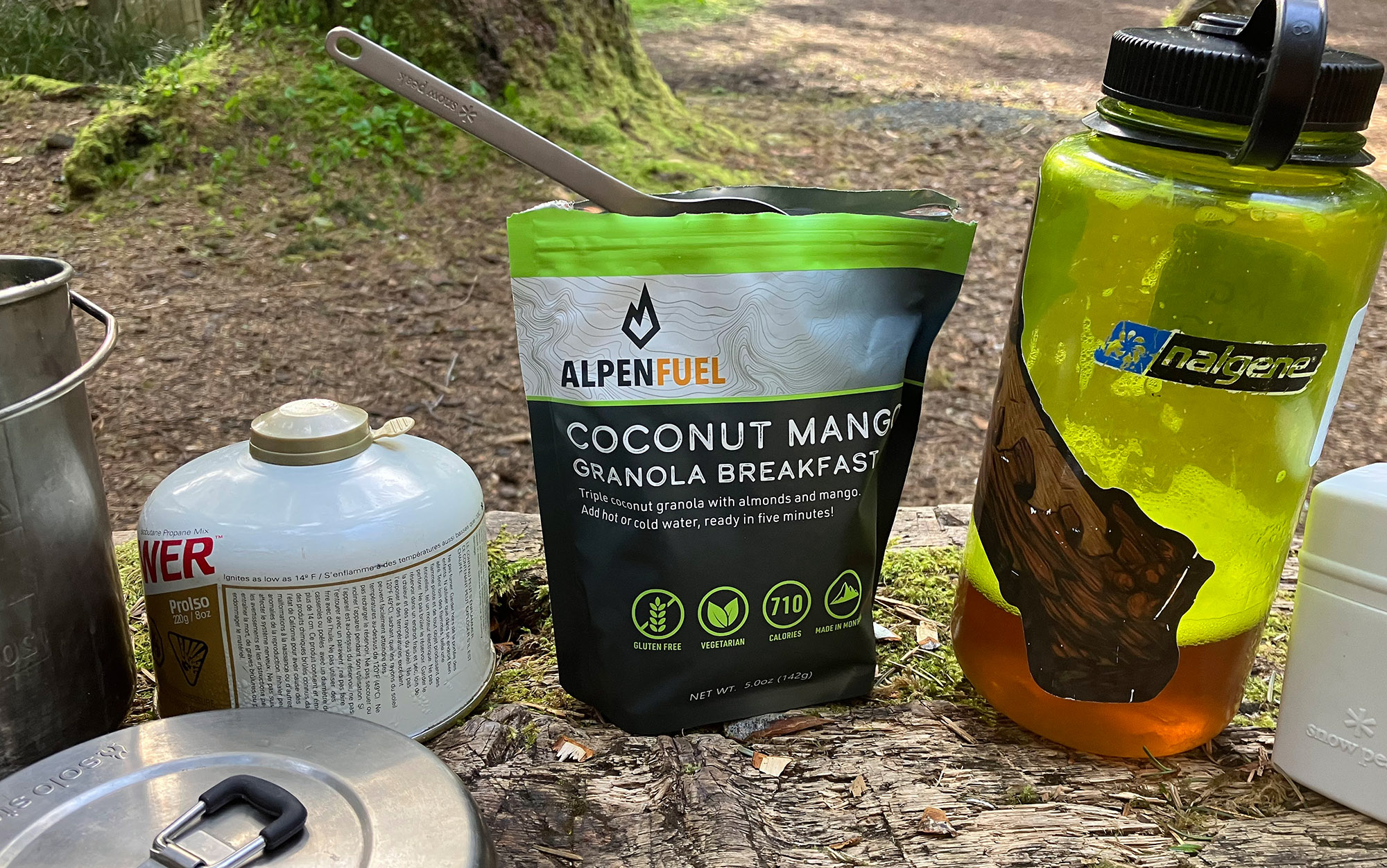
Alpen Fuel backpacking food has strong flavors, but if you can finish an entire bag, it’ll keep you full and energized for a long time. The high calorie count, protein, and fiber is a nutritional start to a long day. And if you’re going to have a lot of sugar, might as well do it first thing in the morning to get moving. They can be rehydrated cold or hot depending on your mood, the weather, and which flavor you have. For instance, I think the Lemon Berry Granola makes a great cold cereal while the Caramel Apple Granola tasted like apple pie when hot.
Highest Calorie: Peak Refuel
Key Features
- Price: $14
- Shelf Life: 5 years
- Net Weight: 4.59-6.77 ounces
- Protein: 13-53 grams
- Calories: 530-1,100
Pros
- Feels like eating at a local diner
- High-calorie
Cons
- Took more time to rehydrate than stated
The Peak Refuel meals taste great and include a lot of real meat. These calorie- and protein-dense meals are designed for two people but after hiking for 19 miles I easily ate the entire Chicken Pesto Pasta by myself. I would recommend these for big days when you want a hearty refuel, as the name suggests. The Biscuits and Sausage Gravy makes a highly filling and meaty breakfast to fuel a long day or as an indulgence later in your trip.
We did run into an issue where these meals took longer to rehydrate than the package stated. While it doesn’t sound like a big deal now, wait until you’re starving and counting down the seconds to dinner time. However if you’re looking for performance comfort food, Peak Refuel is ideal. But just like real diner food, these meals are very high in sodium. But they kept people full until the next meal.
Best Add-On: Meat Shredz Premium Dried Pulled Pork
Key Features
- Price: $6.99
- Shelf Life: 1 year
- Net Weight: 2.2 ounces
- Protein: 10 grams
- Calories: 160
Pros
- Lightweight
- Protein
Cons
- Very dry
As much as we love tuna and chicken packets, sometimes you just need to switch up your protein add-ons. These packets of dried pulled pork are a great way to add extra protein to almost any dish. Immediately I think of adding pulled pork to Packit Gourmet’s queso dip or topping Immi’s high-protein ramen with sriracha pulled pork. Add it to mac and cheese, burritos, and eggs for better meals and a protein boost. The pork is very dry so I wouldn’t snack on it plain. But if you add some bbq sauce and a pickle, I think you could happily spork this out of the package.
One tester tried the Carolina BBQ Shredz on Backpacker’s Pantry Three Cheese Mac and Cheese and Good to Go’s Thai Curry with success, so it seems the options are endless. At under 3 ounces including packaging and at least two servings per package, it’s definitely worth upping your protein in the backcountry with these.
Best Instant Ramen Upgrade: Immi
Key Features
- Price: $39 for a pack of six
- Shelf Life: 9 months
- Net Weight: 2.4 ounces
- Protein: 21 grams
- Calories: 300
Pros
- Tastes better than Top Ramen
- 21 grams of protein
- 19 grams of dietary fiber
Cons
- Low calorie
- Expensive
Immi’s ramen is higher in protein, lower in sodium, and tastier than other instant ramen brands. While the package says to boil the noodles for 8 minutes, our testers simply added them to boiling water and turned off the heat to wait, and the noodles cooked just fine. If you’re stopping for lunch on a cold day, this is a great way to warm up.
We also appreciated the 19 grams of dietary fiber as backpacking meals can sometimes twist up your digestive system. If you’re looking for additional protein and fat you could add peanut butter, sesame oil, Meat Shredz Sriracha Pulled Pork, or any other toppings you can think of to make this into a bigger meal. While $6.50 a pop is a little steep, it’s tastier than instant ramen or a protein bar and the customization options are endless.
Things to Consider Before Buying the Best Backpacking Food
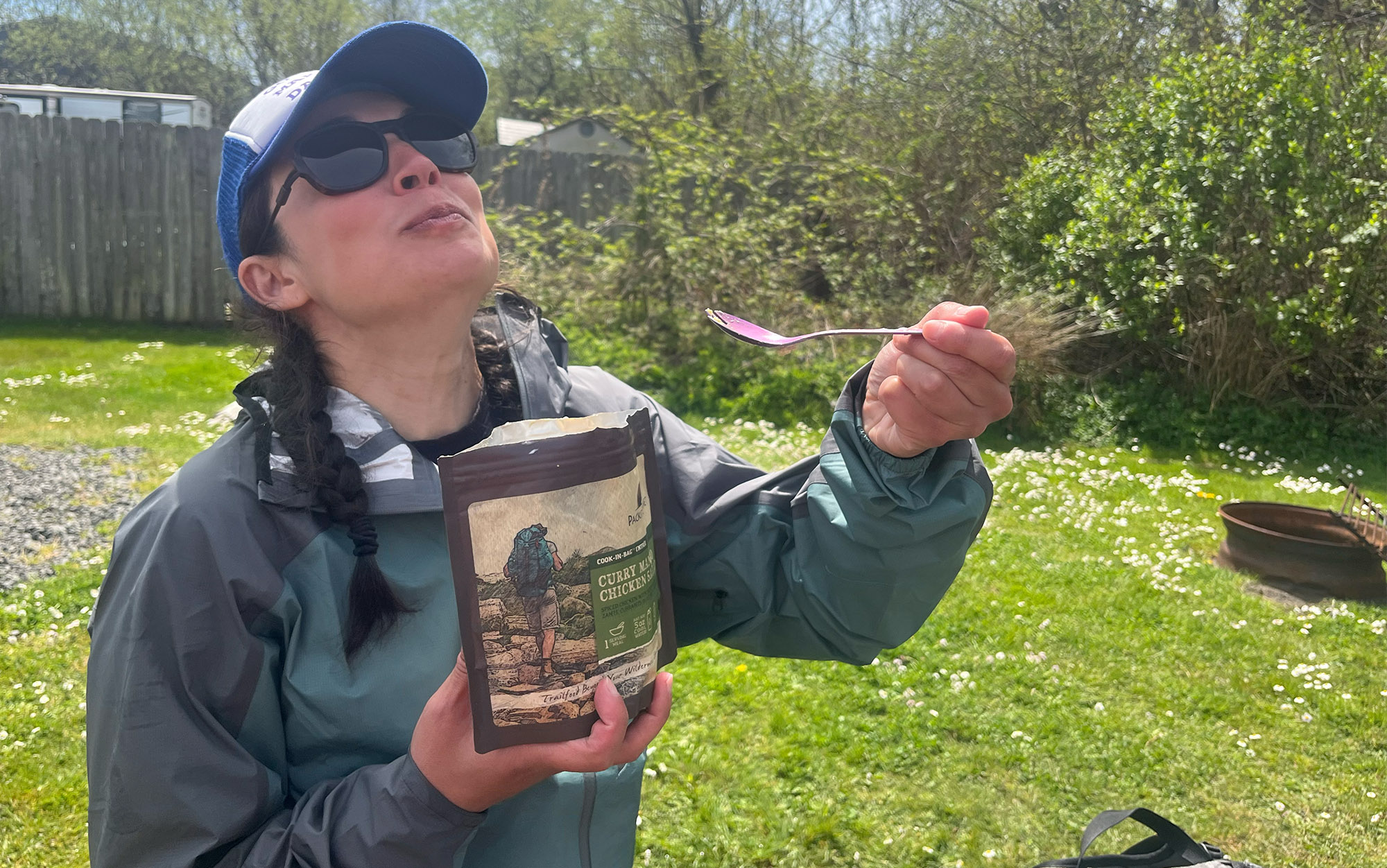
Sodium
The USDA recommends 2,300 milligrams of sodium per day. With sodium counts in the 1,500 milligrams, backpacking meals use extra salt to preserve the food, make it taste better, and replenish your electrolytes. Most people lose between 460 and 1,860 milligrams of sodium per liter of sweat. An hour of vigorous exercise typically makes people sweat 1-3 liters. So while you do need sodium after exercising all day, you can overload. Eating three backpacking meals a day can be too much salt if you are on a more relaxed trip. Common symptoms are increased thirst (which also means you’re carrying more water and taking more bathroom stops), puffiness, and bloating.
Don’t stress about the high sodium levels in backpacking food if you’re hiking a lot, tackling tough terrain, or mixing whole foods into your diet. Your body probably needs it. And if you are worried about consuming too much salt from backpacking food, there are some meals that are lower in sodium than others, just search around a bit.
Preparation
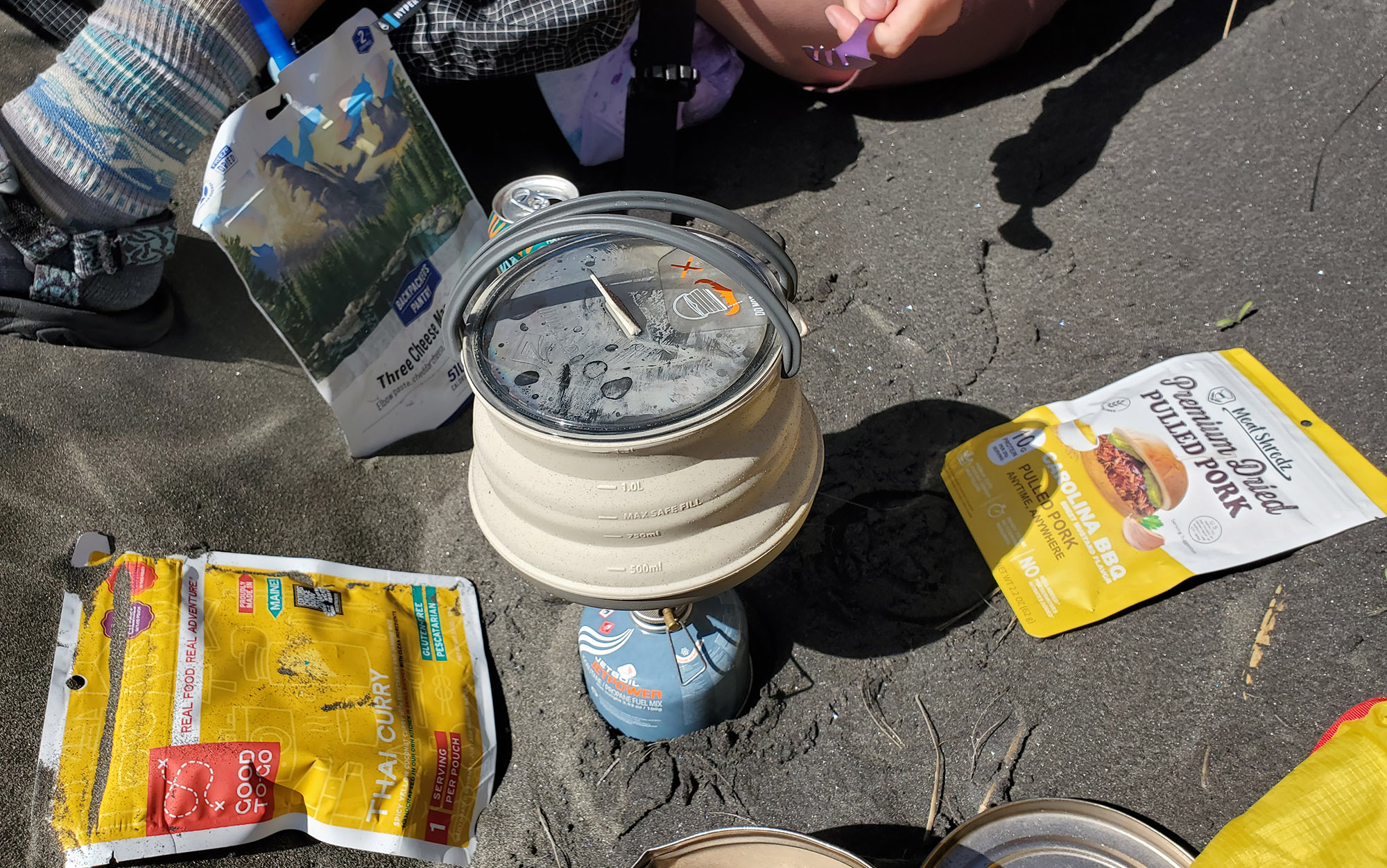
To prepare these meals, all you have to do is add boiling water and reseal the package untl the meal is warm and rehydrated. A few have extras to add in after cooking like a lime or condiment packet.
Some backpacking food requires more time or water to rehydrate than others. Your elevation can also prolong cooking times. Pay attention to the preparation when you’re purchasing so that you aren’t surprised by a 15-20 minute dinner delay. Also factor the required water into your day’s stash. If you aren’t camping near water, you’ll want to bring extra for cooking.
After eating so many backpacking meals in a row, we developed some pro tips for cooking as well. Stir your bag frequently and intensely; it really makes all the difference. Stir when you add the water, being sure to dredge up the seasonings at the bottom. While it rehydrates in the bag, give the bag a massage. And stir it up again once complete to fluff up your carbs and incorporate all the ingredients.
The bags don’t have water fill lines so when it says to add a specific amount on the instructions, you might be guesstimating. Try to bring a water bottle, pot, or cup that has measurement markings if you want to be exact. Lots of hikers dive into backpacking food after the recommended time regardless if the meal is completely rehydrated or not. Eating crunchy food doesn’t seem so bad when you’re ravenous but it might make your stomach hurt later. Some testers experienced digestion discomfort after consuming semi-raw backpacking food.
Is Backpacking Food Right for You?
While hiking along the 362-mile Oregon Coast Trail, our group ate backpacking meals for breakfast, lunch, and dinner from various brands and sampled most meals. Patrice, the only tester who eats backpacking meals regularly, reported that she was feeling fine. Resident staff writer Laura, whose front country nickname is “Lady Garbage Gut,” was also unaffected. The rest of us only treat dehydrated meals as a treat, convenience, or emergency backup. And we were certainly feeling the effects. “I’m not an astronaut; this isn’t in my paygrade,” said tester Jac Mitchell on the final day of backpacking food testing.
While my digestive tract was tied up in knots, Jac was experiencing the opposite problem. Diana Helmuth experienced perpetual stomach acid and the three of us puffed up in the face, hands, and feet. I couldn’t get my rings off my fingers by morning three. Diana said, “I didn’t know my face could get this puffy.” Once we were relinquished from our testing responsibilities, all five of us celebrated with salads (and pizza sushi).
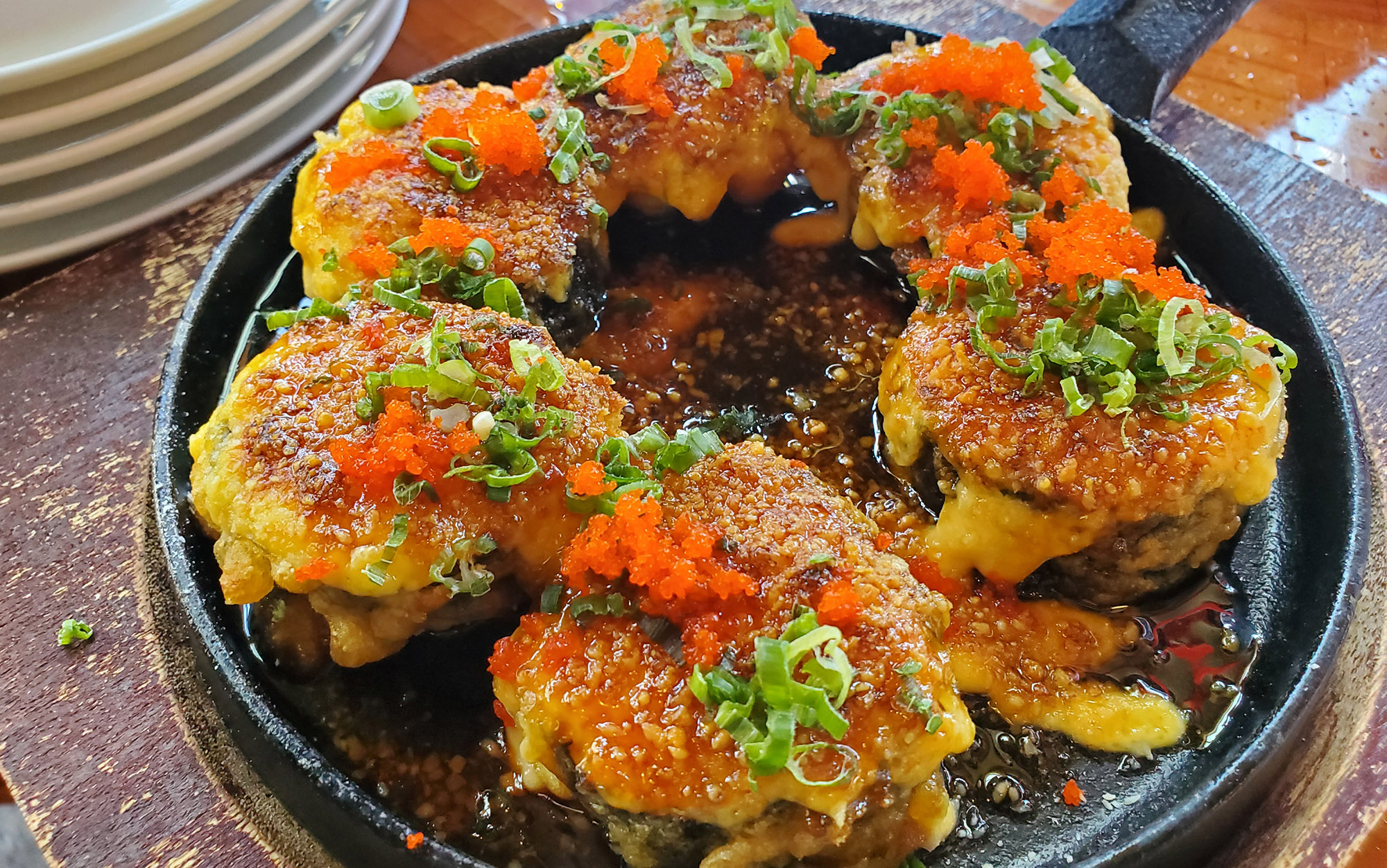
This is not to deter you from backpacking food in general. If you eat one a day, you’ll be perfectly fine. However the increased sodium and still crunchy non-hydrated bits meal after meal are what caused our issues. The meals were mostly tasty and some were easier to digest than others. Dehydrated backpacking meals are convenient, lightweight, and sometimes delicious. So don’t let our suffering be in vain; use the findings in this article to create the best backpacking food plan possible.
Read Next: The Best Bear Canisters of 2023
FAQs
The best food for backpacking is preserved, tastes good, and is high in protein and calories. You’re burning a lot of calories hiking all day and you need to be refueled by the end of the day. That said, I would not recommend eating backpacking meals for breakfast, lunch, and dinner. Try carrying whole, real, and raw foods if possible, at least for the first day or two. Mixing in these nutritious and fibrous options can save your gut and sanity on trail.
Backpacking food is pricey. There’s no way around it. But you’re paying for convenience. The items on this list range from $8 to $20. Making your own backpacking food can be tricky, though rewarding. So if you want to save time and possibly a disastrous homemade meal or two, buying backpacking meals is safe and easy. Buying in bulk can save you some money, too.
This depends on what kind of wilderness you find yourself in. Your main concerns are bears and rodents. Some wilderness areas mandate a bear canister, but even if they don’t, you might still need it. So call a ranger station or check online about bear activity before you get to your destination. An Opsack or Ursack are odor-proof bags that you can use to discourage mice from visiting your tent in the night.
Why Trust Outdoor Life?
Since 1898, OL has been a leading authority in testing and reviewing hunting gear, fishing tackle, guns and shooting equipment, and much more. We have more than a century-long history of evaluating products, and we’re now bringing that expertise to online reviews. Our editors are experienced outdoorsmen and women, and most importantly, we’re trained journalists. We prioritize field testing and objective data when reviewing products. We conduct interviews with gear manufacturers and engineers as well as outdoor experts so that our readers have an understanding of how and why a product works—or doesn’t.
Advertising does not influence our gear reviews and it never will. While we always focus our coverage on standout products—because we want our readers to be aware of the latest and greatest gear—we also cover the flaws and quirks of any given product.
Final Thoughts
The quality, range, and dietary allowances have grown rapidly in the world of backpacking food. For this list we only included brands that use real food in their backpacking meals. Five testers rotated meals and brands over the course of four days to prepare, eat, and enjoy a variety of the best backpacking food. The findings in this article were drawn from the opinions and favorites painstakingly developed during the Backpacking Gear Test.
- Best Tasting: Stowaway Gourmet
- Best Tasting Runner-Up: Pinnacle Foods
- Best Value: Packit Gourmet
- Best Vegan: Fernweh Food Co
- Best Accessible: Backpacker’s Pantry
- Best Gluten-Free: Good to Go
- Best Granola: Alpen Fuel
- Highest Calorie: Peak Refuel
- Best Add-On: Meat Shredz Premium Dried Pulled Pork
- Best Instant Ramen Upgrade: Immi
